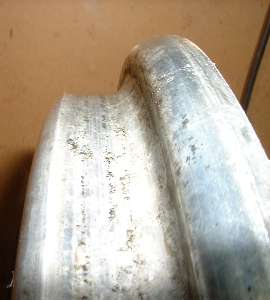The MGA With An Attitude
TUBELESS TIRES & SAFETY RIMS - WL-106
At 11:57 AM 12/3/03 -0500, Dave Ahrendt wrote:
>"On the Heritage Certificate I got for my '59 MGA 1500 it says that it was equipped with tubeless tires as optional equipment. There is no mention of special wheels. It doesn't appear that the wheels I currently have on the car are safety rims but I have no way to know if they are original to the car. Oh yeah, these are steel wheels not wire wheels I'm talking about.
>
>Was there a safety rim available as optional equipment in 59 or had the factory determined that you could run tubeless on the standard rim? ...."
Tubeless tires work fine on the original MGA steel rims. As far as I know my 58 has been running tubeless since new, now with 335,000 miles and no incident, including LOTS of serious autocrossing on race tires. I crack steel wheels from the added stress of the race tires, but they don't lose air.
Safety rims may be an advantage for people who insist on ignoring their tires and run around with very low air pressure. Even then, the safety rim should only come into play if you try to run flat with no pressure. The safety rim is designed to hold the tire bead in place on the rim in the absence of pressure. With normal pressure in a tubeless tire, a standard rim (not safety rim) will hold the tire securely. So you need not worry about this, as long as you maintain reasonable tire pressure, and don't try to run any distance on a flat tire.
 
Standard "J" style wheel rim for MGA Safety rim with groove for tire bead.
Addendum May 2010:
B.F. Goodrich invented tubeless tires in 1946 and introduced them to the automotive market in 1948 (for the 1949 model year). They came into common use on other cars by the mid 50's. Apparently Dodge used safety rims on a production car as early as 1940 (others perhaps earlier). There were sweeping mandates for federal auto safety standards (in the USA) in 1968, but I don't know if safety rims were included in that legislation (they were required on federal government fleet cars). Between introduction of tubeless tires and universal use of safety rims there were many millions of cars using tubeless tires on J-type wheels (not safety rims), including MGA running the optional tubeless tires.
To the best of my knowledge my MGA with steel wheels has always run tubeless tires. It had 150,000 miles on it when I bought it an 1977 (with tubeless bias ply tires), now having 380,000 miles. I suppose it has worn out more than a dozen sets of street tires and several sets of race tires, and has never suffered a rim leak or tire-from-rim separation. Tubeless tires work fine on J-wheels as long as there is a little pressure inside. You can also buy tubeless wire wheels with the spokes sealed. The modular alloy racing wheels I bought in 1994 have J-type rims (not safety rims). I used those with tubeless race tires for serious autocross until 2001, and I still drive on them today with tubeless street tires.
Safety rims are intended to keep a tire on the rim for a while if run with very low air pressure, so you might have a chance to drive it a little way on a nearly flat tire to get service help. There was an auto safety series show on TV some years ago demonstrating that a car might be driven up to 5 miles at 5-mph on a flat tire (if you have enough patience to stay slow). The totally flat tire will eventually come loose from the rim even with a safety rim. Having a tube inside will make no difference if it goes to zero air pressure.
|